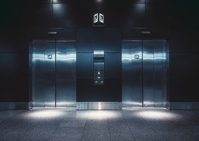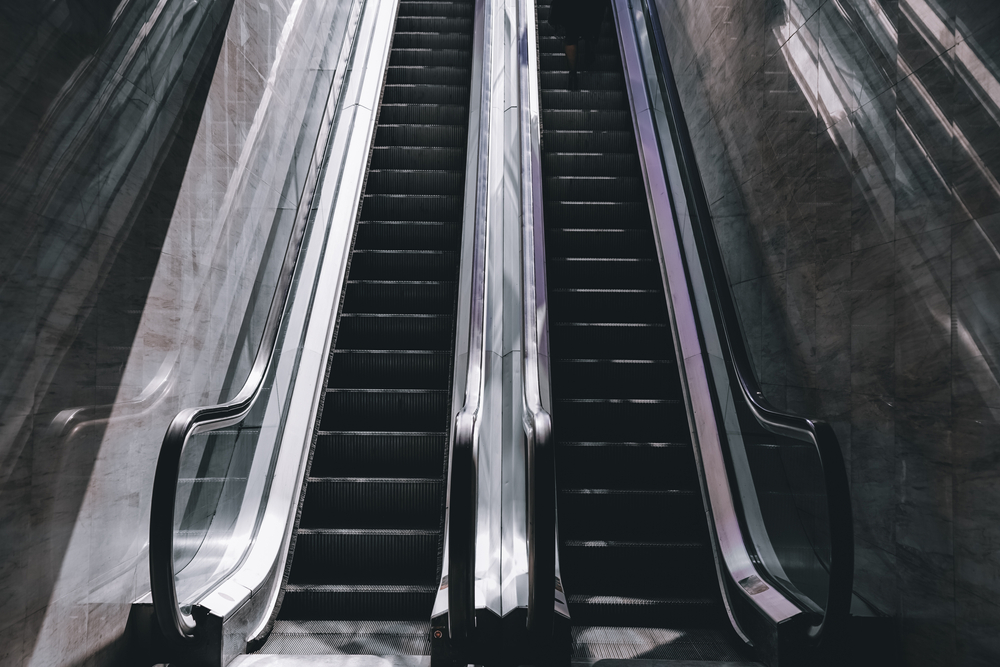Elevators and escalators are everywhere in multi-leveled facilities such as shopping malls, cruise ships, plazas, government and offices, condo and apartment buildings, and many other locations. These complicated pieces of machinery require ongoing checks and maintenance to ensure that they remain operational and safe. A failure to identify and correct any issues can lead to serious or even fatal injuries for anyone using the machinery at the time of the failure.
For example, the lawyers at Lipcon, Margulies & Winkleman, P.A. handled a case where a hydraulic elevator was not regularly and properly maintained by the property manager. The elevator car became stuck in the shaft at a high floor. Because of the lack of maintenance, two simple nuts backed out of the slack safety device, which allowed the elevator to free fall a significant distance after it shifted within the elevator shaft, causing significant personal injury. After identifying the failure and the lack of maintenance that caused it, the lawyers at Lipcon, Margulies & Winkleman, P.A. were able to secure a significant recovery for their client.
Trying to navigate the complexities of a personal injury case — whether against a property owner, management company, or even an elevator or escalator manufacturer — can be complicated on the best of days. When a victim is trying to deal with a host of impacts after an accident, it can feel nearly impossible to fight through this legal process alone. This is why working with an award-winning team of personal injury lawyers like those at Lipcon, Margulies & Winkleman, P.A is one of the best ways to work towards getting the money you deserve without taking away from your ability to focus on your recovery.
Contact Lipcon, Margulies & Winkleman, P.A To Request a Free Consultation After an Elevator or Escalator Accident Today
For decades, the lawyers at Lipcon, Margulies & Winkleman, P.A have successfully represented personal injury victims through a range of cases, including cruise ship injuries and other maritime-related accidents, sexual assaults, hotel and resort accidents and incidents, land-based premise liability and security incidents, construction accidents, as well as countless other types of civil claims and lawsuits. Working with a proven team of attorneys is one of the best ways to get a clear understanding of your rights as a victim, build a solid and aggressive legal case, and stay focused on getting the medical care you need — as well as the emotional and personal support that will help you move forward from such a painful and traumatic event.
Read more below to get a better sense of how an elevator or escalator case may be handled in a civil case, and contact our law firm as soon as possible to connect with a highly-respected team of legal professionals.
Escalator & Elevator Accident Common Causes
There are many different ways someone can be hurt on an elevator, whether caused by their actions or someone else’s negligence or recklessness. The following causes are specifically related to those accidents that may be considered a tort violation. There are countless other examples of accidents that can lead to civil cases not mentioned below.
Whether or not you see your accident cause mentioned below, contact our firm as soon as possible to speak with the team at Lipcon, Margulies & Winkleman, P.A about how you can fight to get the care and compensation you rightfully deserve for your involvement in such a challenging experience.
Maintenance Issues
Elevators and escalators are complicated pieces of machinery that require inspections carried out by licensed technicians to identify any possible issues and give the devices the maintenance they need to continue functioning reliably and safely. While defective mechanisms cause some mechanical failures, more often, these accidents stem from a failure to provide adequate maintenance, and as the machine slips into disrepair, the safety of its riders is put in jeopardy.
Mechanical Failure
Aside from issues stemming from wear and tear that was not properly maintained, there is the additional risk of mechanical failures on an elevator or escalator due to manufacturing problems with the mechanisms, defective pieces of electronics or hardware, and more. After an accident caused by a mechanical failure due to manufacturing, a victim’s legal hurdles may be even more complicated as they try to work through each party involved to identify the at-fault — and therefore financially liable — party.
Reckless Riders
Not all accidents while using elevators or escalators are caused by the devices themselves. People are sometimes injured in accidents caused by other people they are sharing the space with. Rough play or aggressive behavior on an escalator, for example, can lead to injuries where security in the area is inadequate and unresponsive.
Injuries Sustained from An Elevator or Escalator Accident
Because elevators and escalators are tools that necessarily exist in multiple changes in levels, injuries occurring as a result of elevator or escalator accidents are often catastrophic or fatal. Injuries very often include one or more of the types listed below:
Lacerations
A laceration, also known as a cut or tear, can result in various amounts of damage to the skin. The severity depends on the laceration’s location, depth, length, and size. A deep gash that extends across an entire limb is more severe than a shallow scratch along your arm because it has greater potential for complications. The chances for scarring increase with deeper cuts as well as those that cover a larger area of the body.
Fractures
A fracture is a medical condition in which one or more bones are cracked or broken due to trauma to the affected area. A fracture can occur in any bone, but most commonly affects weight-bearing bones such as the legs and spine. These types of injuries require immediate medical attention to ensure that the bones are set and able to heal properly, and if left without being properly set, may heal incorrectly and require that the bone is re-broken in a procedure to help the victim regain full mobility and use of the affected area.
Spinal Cord Injuries
A spinal cord injury (SCI) is damage to the nerves in your spine that carry messages back and forth from your brain to your body. The spinal cord is protected by bones, called vertebrae, which are organized into sections separated by areas of disc. Nerves run through these spaces like electrical wires running through a protective pipe. When part of this protective pipe—the vertebral column—is damaged, it can cause nerve damage (also known as a “spinal cord injury”).
Traumatic Brain Injuries
A traumatic brain injury (TBI) is a type of acquired brain injury resulting from damage to the brain caused by an external force, such as rapid acceleration or deceleration, impact with an object, or penetration by an object. Almost all TBIs involve some damage to blood vessels, but this does not necessarily mean there is bleeding in the skull. Portions of the skull may be fractured and broken and still contain intact blood vessels. These injuries can cause tearing and shearing of neural tissues and small blood vessels within the brain itself. The difference between a mild and severe TBI often lies in the extent of these neural injuries.
Key Elements of an Elevator & Escalator Accident Claim
All personal injury cases are complicated, and the following “key elements” only give a small sense of the many different details your attorney will need to work through while fighting to recover compensation for the many damages you have likely suffered.
Identifying the Cause of the Accident
Before anything else can happen, you and your lawyer will need to come to an understanding of how the elevator or escalator accident happened. There is a significant difference between someone falling on an escalator due to improper use (such as running up a down escalator, sliding down the handrails, etc.) and an accident happening because of a mechanical failure or someone else’s behavior, so identifying the cause and then determining whether or not it entails a failed duty of care is an essential first step. The lawyers at Lipcon, Margulies & Winkleman are familiar with the types of situations that lead to elevator and escalator injuries and work with the most qualified experts in the elevator and escalator industry to identify the specific issues and events which caused the accident.
Proving Fault and Liability
Once the cause of the accident is established, the next step will be to identify the responsible party or parties. In the case of an elevator or escalator accident, the at-fault party is usually the owner or manager of the property, the elevator or escalator maintenance company, the manufacturer, or others.
Once fault is identified, the next step will be to prove that the at-fault party is liable for the victim’s damages, which your attorney will be able to handle while you focus on your personal needs and recovery.
Calculating Damages and Seeking Fair Compensation
Once liability is determined, your lawyer will set out to gather information and supporting evidence about each of the many damages — impacts and losses — that you have suffered as a result of your accident, including things like your medical bills, lost wages, and even the emotional impacts and pain and suffering you have endured because of this situation.
Once these damages are calculated, an experienced elevator and escalator accident attorney will either directly negotiate with the at-fault party or their liability insurance and may choose to file a lawsuit to fight for total compensation beyond reaching a settlement agreement. No two cases are alike, so working with an experienced and proven personal injury lawyer is one of the best ways to ensure that you are fighting as aggressively as necessary to get what you rightfully deserve.
Experienced Legal Representation from Lipcon, Margulies & Winkleman, P.A.
The sooner you contact our firm, the sooner we can begin the process of getting you the money you are entitled to after suffering from an accident that someone else caused. Request a free consultation directly from our website, or call us right away to take an essential step in your personal injury journey.
Other Practice Areas
- Cruise Ship Accidents
- Maritime Lawyer
- Boating Accidents
- Yacht Accident Lawyers
- Parasailing Accidents
- Jetski Accidents
- Seafarers Rights Attorney
- Dock Accidents
- Scuba Diving Accidents
- Swimming Pool Drowning Accidents
- Commercial Fishing Accidents
- Barge Accidents
- Riverboat Accidents
- Ferry Accidents
- Tender Boat Accidents
- Airbnb Lawyer
- Short Term Rental Lawyer







